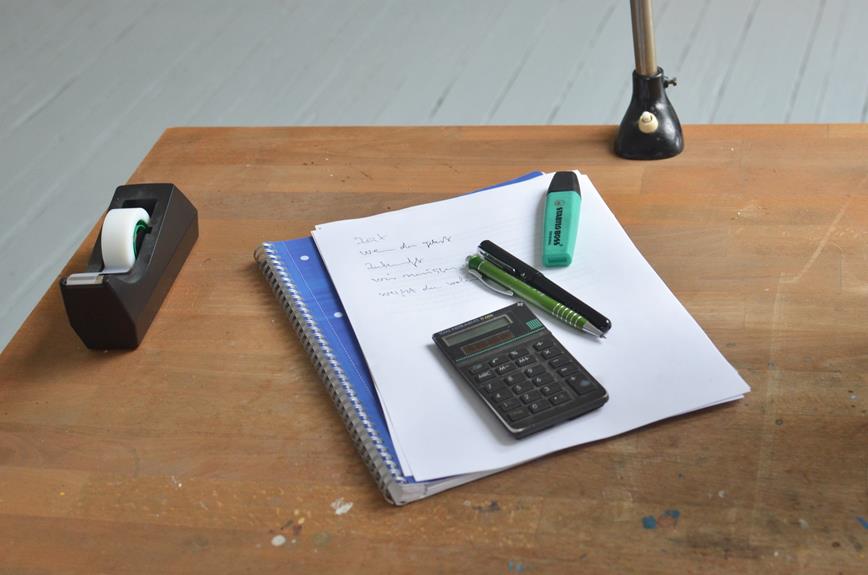Wondering if there's a way to remove permanent marker from your home office wood desk? Look no further. You've come to the right place to master the art of banishing those stubborn stains.
With the right techniques and supplies, you can restore your wood desk to its former glory. Follow these steps to confidently tackle the task at hand and bid farewell to that unwanted permanent marker residue.
Key Takeaways
- Determine the extent of the marker stain and the type of wood surface before selecting a stain removal method.
- Test any cleaning solution on a small, hidden area of the desk first to avoid potential damage to the wood finish.
- Rubbing alcohol or hand sanitizer can effectively remove permanent marker ink, but it's important to test on a small area first.
- Baking soda and toothpaste can be mixed together to create a mild abrasive solution for removing marker stains from wood surfaces.
Assessing the Permanent Marker Stain
When assessing the permanent marker stain on your home office wood desk, you'll want to first determine the extent of the marking and the type of wood surface you're dealing with. Different wood finishes and sealants can react differently to stain removal techniques, so identifying the specific type of wood is crucial. Once you have this information, you can proceed with confidence to select the most appropriate method for removing the stain without causing damage to the desk.
Wood desk maintenance is an essential aspect of preserving the integrity and appearance of your furniture. Regular cleaning and polishing can help protect the wood surface and make it easier to address stains when they occur. When it comes to permanent marker stains, there are various techniques you can employ, such as using rubbing alcohol, baking soda paste, or even commercial wood cleaners specifically designed for stain removal. It's important to test any cleaning solution on a small, inconspicuous area of the desk first to ensure it doesn't cause further damage.
Gathering the Necessary Supplies
To start removing permanent marker from your home office wood desk, gather up the necessary supplies, such as rubbing alcohol, microfiber cloths, and a soft-bristled brush. These supplies are essential for effectively tackling the permanent marker stain without causing damage to your desk.
- Rubbing Alcohol: This powerful solvent is effective in breaking down the permanent marker ink, making it easier to remove from the wood surface.
- Microfiber Cloths: These soft and gentle cloths are perfect for wiping away the loosened ink without scratching or damaging the wood.
- Soft-Bristled Brush: Using a soft-bristled brush allows for gentle scrubbing to lift the marker stain without harming the wood finish.
Finding alternatives to harsh chemicals and abrasive materials is crucial to avoiding damage to your desk. It's important to approach the stain removal process with care and precision to ensure that your desk remains in pristine condition.
Testing a Small, Hidden Area
Before proceeding with removing the permanent marker from your home office wood desk, locate a small, hidden area on the desk surface to test the rubbing alcohol and ensure it doesn't cause any damage. Testing methods are crucial to prevent any potential harm to the wood finish. Apply a small amount of rubbing alcohol to a soft cloth and gently rub it on the hidden area. Check for any adverse effects such as discoloration, smudging, or damage to the wood. If the test area shows no negative impact, you can proceed with confidence to remove the permanent marker from the visible areas of your desk.
Taking preventative measures such as testing the rubbing alcohol on a hidden spot is essential to avoid causing further damage to your desk. It's a simple yet effective way to ensure that the method you choose for removing the permanent marker won't harm the wood surface. By conducting this quick test, you can proceed with peace of mind, knowing that your desk will remain unscathed.
Using Rubbing Alcohol or Hand Sanitizer
You can try using rubbing alcohol or hand sanitizer to remove permanent marker from your wood desk.
Rubbing alcohol is effective in breaking down the marker's pigments, while hand sanitizer can be applied directly to the stain for a similar effect.
Make sure to test a small, hidden area first to ensure that the alcohol or hand sanitizer doesn't damage the wood finish.
Rubbing Alcohol Effectiveness
Using rubbing alcohol or hand sanitizer can effectively remove permanent marker from your home office wood desk. When considering rubbing alcohol alternatives, remember that hand sanitizer with a high alcohol content can also be effective.
It's important to test a small, inconspicuous area of your desk first to ensure the alcohol doesn't damage the finish. Additionally, when using rubbing alcohol, be sure to apply it to a clean cloth rather than directly onto the wood to avoid potential damage.
Remember that while rubbing alcohol is effective for removing permanent marker, it's important to consider long-term wood care. After removing the marker, consider applying a wood polish or wax to maintain the desk's finish and protect it from future damage.
Hand Sanitizer Application
To effectively apply hand sanitizer for removing permanent marker from your home office wood desk, ensure that it contains a high alcohol content, as this is crucial for successful removal. Hand sanitizers with high alcohol content can effectively break down the permanent marker ink on your wood desk. When applying hand sanitizer, use a soft, clean cloth and gently dab the affected area. Avoid rubbing vigorously, as this could damage the wood finish. If you don't have hand sanitizer with high alcohol content, rubbing alcohol can be used as an alternative. After applying the hand sanitizer or rubbing alcohol, make sure to clean the area with a mild wood cleaner and polish to maintain the desk's finish. Here's a comparison of hand sanitizer and rubbing alcohol for removing permanent marker from wood desks:
| Hand Sanitizer | Rubbing Alcohol |
|---|---|
| High alcohol content | Effective solvent |
| Gently dab with cloth | Gently dab with cloth |
Applying Baking Soda and Toothpaste
To remove permanent marker from your home office wood desk using baking soda and toothpaste, first mix equal parts of both ingredients in a small bowl. Apply the mixture to the marked area and gently rub it in with a soft cloth. Let it sit for a few minutes before wiping it off with a clean, damp cloth.
Here's why this method is effective:
- Baking soda is a mild abrasive that helps to lift the marker stain from the wood surface, making it easier to remove.
- Toothpaste contains gentle cleaning agents and abrasive particles that work in conjunction with the baking soda to break down and lift the marker stain.
- The combination of baking soda and toothpaste creates a powerful cleaning paste that not only removes the marker stain but also helps to polish and protect the wood surface.
Using baking soda and toothpaste to remove permanent marker from your wood desk can be a highly effective method, providing a gentle yet thorough approach to tackling tough stains. With patience and precision, you can master this technique and restore the pristine look of your desk.
Finishing With a Protective Sealant
Once you have successfully removed the permanent marker from your wood desk, apply a protective sealant to safeguard the surface from future stains and damage. This is an essential step in wood desk maintenance to ensure its longevity and keep it looking its best. A protective sealant creates a barrier that helps prevent liquids and other substances from penetrating the wood, making it easier to clean and maintain. Additionally, it adds a layer of protection against scratches and daily wear and tear, preserving the natural beauty of the wood.
| Benefits of Applying a Protective Sealant |
|---|
| Enhances the Desk's Durability |
| Provides Stain Resistance |
| Preserves the Wood's Natural Look |
Applying a protective sealant is a simple yet effective way to care for your wood desk, and it is a worthwhile investment in maintaining the quality and appearance of your furniture. When selecting a sealant, ensure that it is suitable for the type of wood and finish on your desk. Follow the manufacturer's instructions for application and reapplication to keep your desk well-protected for years to come.
Frequently Asked Questions
Can Permanent Marker Stains Be Removed From Other Types of Wood Furniture, or Is This Method Specifically for Home Office Desks?
You can remove permanent marker stains from other wood furniture with alternative solutions like using natural cleaners or seeking professional restoration. It's important to consider the type of wood and finish when choosing the best approach.
Are There Any Potential Risks or Damage to the Wood Surface When Using Rubbing Alcohol or Hand Sanitizer to Remove Permanent Marker?
Using rubbing alcohol or hand sanitizer to remove permanent marker from a wood surface can potentially cause damage. These methods may strip the protective sealant and harm the wood. Consider alternative methods such as toothpaste, especially for painted wood surfaces.
How Long Should I Wait Before Applying a Protective Sealant After Using the Baking Soda and Toothpaste Method?
After using the baking soda and toothpaste method to remove permanent marker from your wood desk, wait for the surface to completely dry before applying a protective sealant. The waiting period may vary depending on the wood type. Alternatively, consider other protective sealing methods.
Can I Use These Methods to Remove Permanent Marker From Painted Wood Surfaces?
You can prepare the surface by cleaning it with suitable products like rubbing alcohol or acetone. Be cautious with abrasive methods as they may damage wood finishes. Apply a protective coating after removing the marker.
Are There Any Alternative Methods for Removing Permanent Marker From Wood Desks That Don't Involve the Use of Rubbing Alcohol or Hand Sanitizer?
You can consider using alternative methods to remove permanent marker from wood desks, such as natural solutions like baking soda or non-toxic options like white vinegar. These eco-friendly alternatives can effectively tackle the stains.




